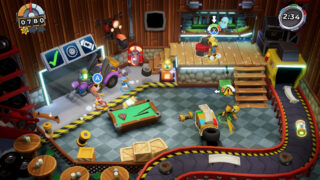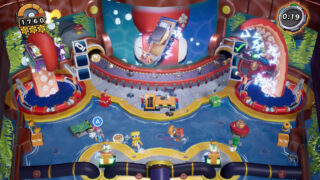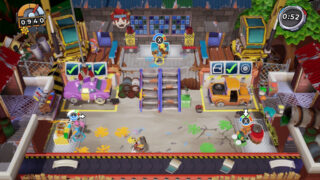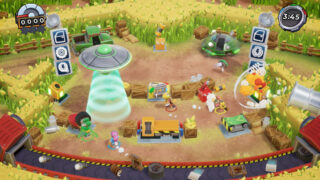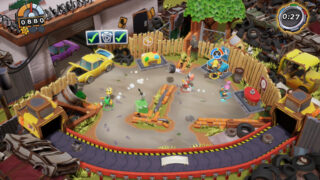Hands-on: Manic Mechanics is a fun new co-op game from Minecraft developer 4J Studios
We go behind the wheel of the Scottish studio’s first new IP in nearly 15 years
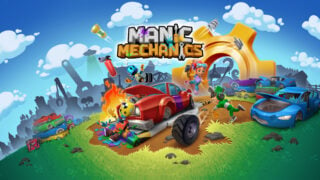
These days, 4J Studios is best known as the team behind the console versions of Minecraft. That wasn’t always the case, however.
Back in the day, the Scottish studio worked on other projects, including the Xbox Live Arcade ports of Banjo Kazooie, Banjo Tooie and Perfect Dark.
It used to create its own original titles too, but it’s now been 15 years since the studio last released a console game that wasn’t a port or remaster. While Microsoft and Minecraft have clearly been kind to 4J, then, it’s understandable that it also wants to show it’s still capable of doing its own thing.
Last year, it was announced that 4J would be entering the world of publishing, with plans to release a number of Scottish-developed games starting with the promising Skye Tales. It turns out that 4J’s plans go beyond publishing other studios’ titles, however.
Earlier this week we visited its office in Dundee for a sneaky peek at Manic Mechanics, ahead of its official reveal during the latest Nintendo Direct presentation. It’s the team’s first original IP in nearly a decade and a half, and from what we’ve played it’s a strong first step back into the world of self-expression.
The best way to describe Manic Mechanics is ‘Overcooked with cars’. There’s obviously more to it than that, but it’s probably the easiest initial image to form in your head. The game features a series of missions that take place in themed worlds, and the aim in each is to complete the unfinished cars that make their way through the production line.
Each car has a few missing parts, so it’s up to the players to work together to grab these parts from a nearby conveyor belt, process them accordingly and apply them to the car so it can be sent off and replaced with the next incomplete one.
The processing part is the game’s equivalent of the food preparation in Overcooked – this time, instead of chopping tomatoes and mushrooms, you’re painting car doors, charging car batteries and… um, hitting engines with hammers (look, it’s all very technical).
Each of these tasks is performed with a different control method – painting involves moving the stick left and right, engines are fixed by button-bashing, batteries can be left to charge on their own but have to be removed once they’re full or else they might blow up, that sort of thing.
This means players not only have to remember which bespoke workstation is suitable for each car part, but also which mini game-style button combination they have to use to prepare it. Thankfully there are button prompts to remind you, though obviously you can get the work done quicker if you already know what to do.
As players work their way through the stages and things get progressively harder, new parts are added to the fray and combination parts are introduced. Electric cars, for example, require you to combine a charged battery with an engine to make an electric engine.
On top of this, stages also have unique hazards, which also have to be avoided to make sure the production line is running as smoothly as possible. One stage has UFOs swooping around and abducting players, for example, while another is set at a ten-pin bowling alley, meaning players have to be wary of bowling balls hurtling along the floor.
In the trickiest of the stages we played, large parts of the floor were severely flooded. This isn’t particularly hard to navigate, but if you enter the water while carrying something electric (such as a charged battery) the entire body of water gets electrified and anyone standing in it is stunned, dropping what they’re holding. This means to get charged batteries around the stage you’ll have to throw them over the water.
Manic Mechanics can be played solo, with the game’s difficulty scaling up and down depending on how many players are taking part. 4J did stress to us, however, that the game was developed with couch co-op in mind.
Having spent some time playing with three of the game’s developers it’s clear that this is indeed where the most fun is to be had, especially when the difficulty ramps up and players are throwing parts all over the stage in an attempt to speed up the process, inevitably hitting other players and causing carnage as a result. We’re not ashamed to say that even playing with three experts we still ended up turning the air bluer than a dead Sonic at times.

Ultimately, we came away happy with what we played of Manic Mechanics so far. The game’s set to be released on July 13, and the hope is that the game will be successful enough to perhaps turn it into a series or add DLC.
4J also assures us it has more new games on the way, including those other titles from third-party Scottish studios it’s set to publish. While its work on the Minecraft console ports has made it one of the most financially successful studios in Scotland, it couldn’t be clearer while talking to management and developers alike that there’s true ambition here to establish itself as one of the most creatively successful ones too.
The studio has been working on the console versions of Minecraft for more than a decade now, and there’s no sign that particular journey will run out of road any time soon (if you’ll forgive the analogy). That said, if Manic Mechanics is the first indicator of the path 4J will be taking in the future, it certainly suggests it might be worth buckling up and joining it for the ride.




